This is a puzzle to remember! Expect an unexpected twist and turn.
|
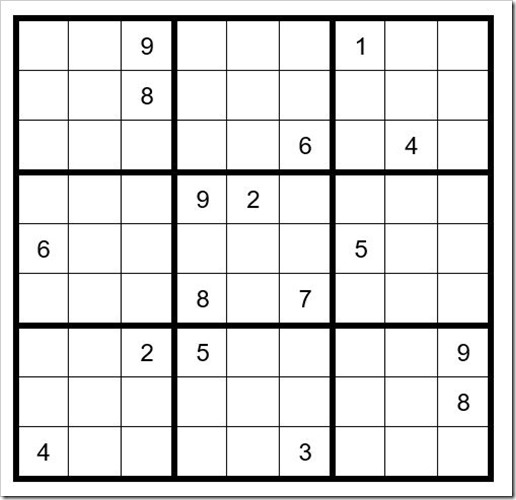
Puzzle #41
|
DAN’S 8 STEP APPROACH TO SOLVING ALL SUDOKU PUZZLES
Once you have completed the puzzle, to the extent that you have filled-in all obvious answers and have written all potential options across the top of the unsolved cells (PUZZLE PREPARATION), Dan recommends the following Steps to complete the puzzle.
See TI Life Puzzle Preparation: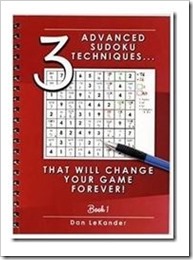
Step 1: Sudoku Pairs, Triplets and Quads – September 2015
Step 2: Turbos & Interaction – October 2015
Step 3: Sudoku Gordonian Rectangles and Polygons – November 2015
Step 4: XY-Wings & XYZ Wings – December 2015
Step 5: X-Wings – January 2016
________________
Step 6: DAN’S YES/NO CHALLENGE
Step 7: DAN’S CLOSE RELATIONSHIP CHALLENGE
Step 8: AN EXPANSION OF STEP 7
Steps 1-5 are relatively common techniques and are explained in the TI LIFE articles above. Steps 6-8 are covered in detail, in Dan’s book.
Also, see Sudoku Puzzle Challenge… February 2016, March 2016, April 2016, May 2016, June 2016, July 2016, August 2016, September 2016, October 2016, November 2016, December 2016, January 2017, February 2017, March 2017 , April 2017, May 2017, June 2017, July 2017, August 2017, September 2017, October 2017 , November 2017 , December 2017, January 2018, February 2018, March 2018, April 2018. and May 2018
As a reminder, the basic rules of Sudoku are that the numbers 1-9 must be contained and cannot be repeated in a row, column, or box, and there can only be one solution to the puzzle.
|
PUZZLE PREPARATION
Prior to utilizing these techniques, first complete the 4 Steps of Puzzle Preparation …
- FILL IN OBVIOUS ANSWERS
- FILL IN NOT-SO-OBVIOUS ANSWERS
- MARK UNSOLVED CELLS WITH OPTIONS THAT CANNOT EXIST IN THOSE CELLS
- FILL IN THE OPTIONS FOR THE UNSOLVED CELLS
OBVIOUS ANSWERS …
Start with the 1’s to see if there are any obvious 1-choice answers. Then navigate the 2’s through 9’s.
The first obvious answer is C5R6=6 (cell in column 5, row 6). Then it follows that C6R4=5.
Now your grid should look like Example #41.1 below:
|
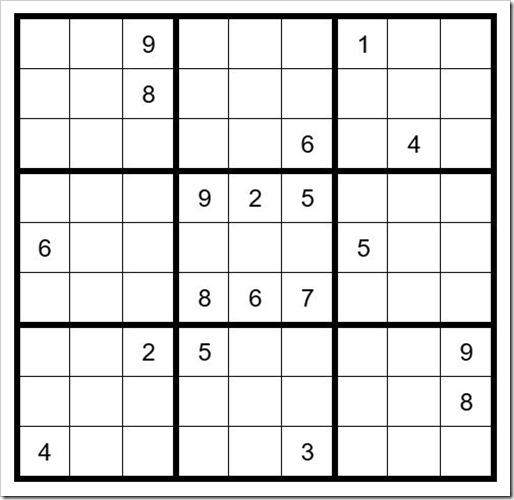
Example #41.1
|
NOT-SO-OBVIOUS ANSWERS …
To begin this exercise, we will look for obvious Pairs, Triplets & Quads and mark the options of the cells in the top of the cells.
We will first examine box 5 (middle box of 3 X 3 cells). The options for cells C4R5, C5R5 & C6R5 can only be 1, 3 & 4, an obvious triplet. Insert the options into your grid for those 3 cells.
The only cells in box 1 that can be a 4 & 6 are C2R1 & C2R2, an obvious pair. Insert the options 46 into those two cells.
Now your grid should look like Example #41.2 below:
|
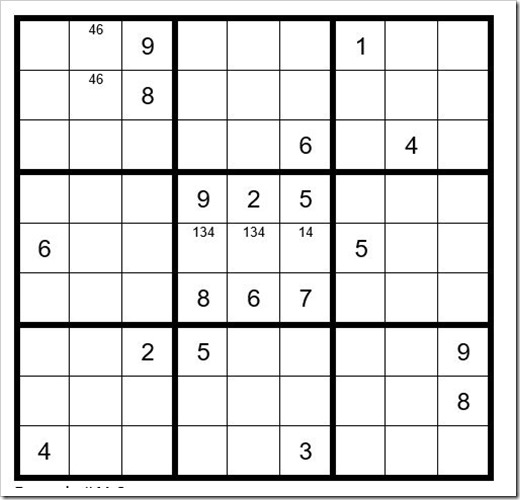
Example #42.2
|
Now we will search for Not-Obvious answers. In row 5, the four unsolved cells without options can only be 2, 7, 8 & 9. C3R5 must therefore be a 7, as there are already a 2, 8 & 9 in column 3. In row 5, the three remaining unsolved cells now can only be 2, 8 & 9. C9R5 must be a 2, as there are already an 8 & 9 in column 9. Fill in the options 89 for C2R5 & C8R5, an obvious pair.
Now your grid should look like Example #41.3 below:
|
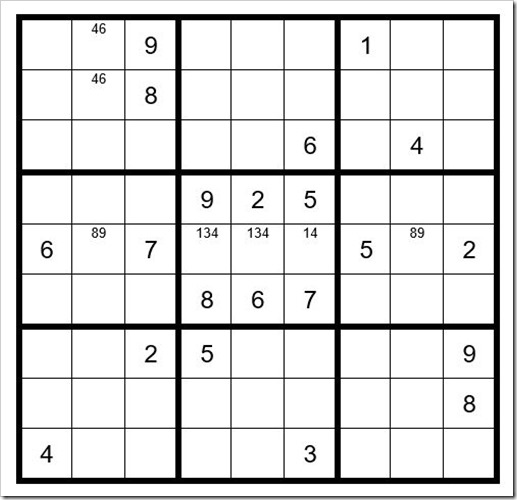
Example #41.3
|
There are no more “Not Obvious Answers”.
MARK UNSOLVED CELLS WITH OPTIONS THAT CANNOT EXIST IN THOSE CELLS …
In box 9 a 4 can exist only in C7R7 or C7R8; therefore, a 4 cannot exist as an option in C7R4 or C7R6. Pencil a small 4 in the bottom of those two cells to indicate they cannot be a 4.
Now your grid should look like Example #41.4 below:
|
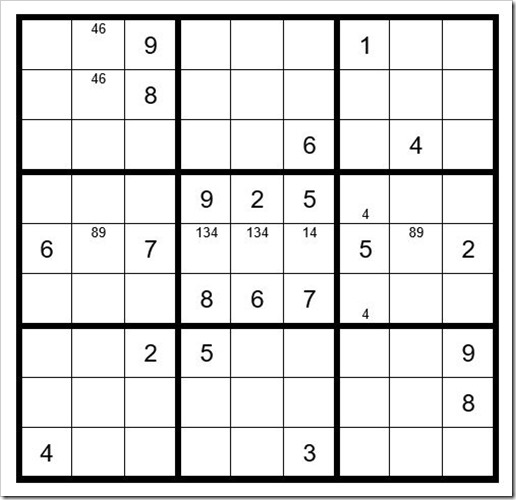
Example #41.4
|
FILL IN THE OPTIONS FOR THE UNSOLVED CELLS …
Once you fill in the options for the unsolved cells, your grid should look like Example #41.5 below:
|
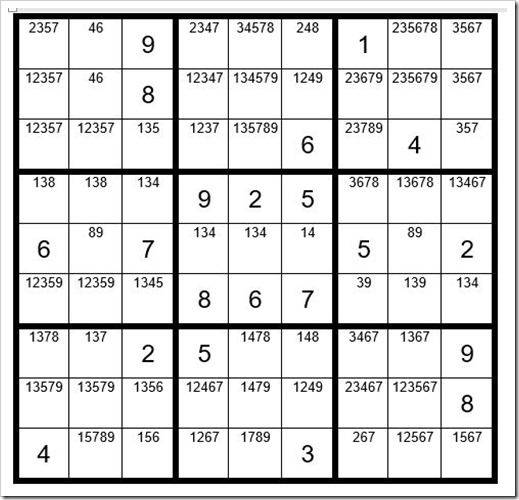
Example #41.5
|
STEPS 1-8
We will begin with Step 1, identifying pairs, triplets & quads. Can you spot any new pairs or triplets in Example #41.5?
The first pair we spot is in row 3. C5R3 & C7R3 are the only two unsolved cells in row 3 that can have options 89, a hidden pair; therefore, eliminate all other options for these 2 cells. Next, we see in row 9 that the only two unsolved cells that can have options 89 are C2R9 & C5R9, another hidden pair; therefore, you may eliminate all other options for those 2 cells. In column 2 we have created an obvious pair 89 in C2R5 & C2R9; therefore, you may remove the 8 & 9 as options for all other cells in column 2. And finally, we see in column 5 we have created an obvious pair 89 in C5R3 & C5R9; therefore, you may remove the 8 and 9 as options from all other unsolved cells in column 5.
Now we will move on to Step 2: Turbos and Interactions. In row 7 we see that only 2 cells that have the option 6 are C7R7 & C8R7. Since these cells are both in box 9, can a 6 exist as an option in any other cells in box 9? No! You may remove the 6 as an option from the other 5 unsolved cells in box 9. Now your grid should look like Example #41.6 below:
|
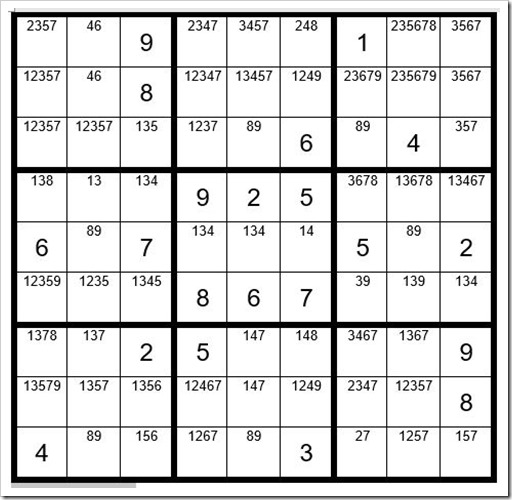
Example # 41.6
|
In continuing our search for other Step 2 clues and then searching Steps 3-5 we find no additional clues.
Step 6: Dan’s Close Relationship Challenge …
There are 3 circumstances that establish the potential for a Step 6 exercise:
- Look for just 2 unsolved cells in a box that contain the same option where these 2 cells are not in the same row or column.
- Look for just 2 unsolved cells in a column that contain the same option where these 2 cells are not in the same box.
- Look for just 2 unsolved cells in a row that contain the same option where these 2 cells are not in the same box.
In column 5 we find just 2 unsolved cells that contain the option 8 … C5R3 & C5R9. These cells are not in the same box, thereby qualifying as a candidate for a Step 6 exercise. These cells are highlighted in yellow in Example #41.7 below:
|
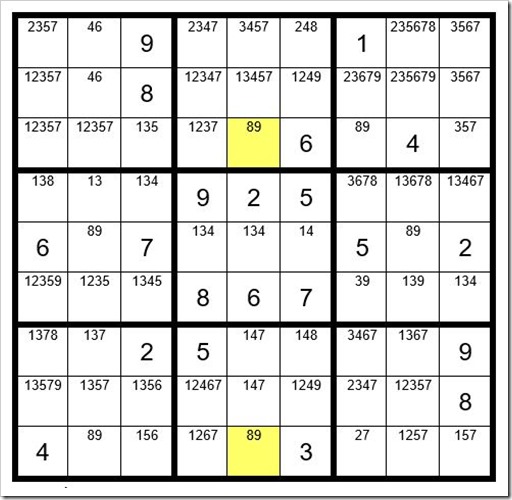
Example #41.7
|
One of these two yellow cells must be an 8. We will consider them as “driver cells” which “drive” the exercise.
Here is the logic. We will perform two exercises. First, we will assume C5R3 is the 8 and see which other cells cannot be an 8. Then we will assume C5R9 is the 8 and see which other cells cannot be an 8.
We will mark C5R3 with a “Y” and mark C1R7 with a lower case “y” to keep track of the exercise as per Example #41.8 below.
|
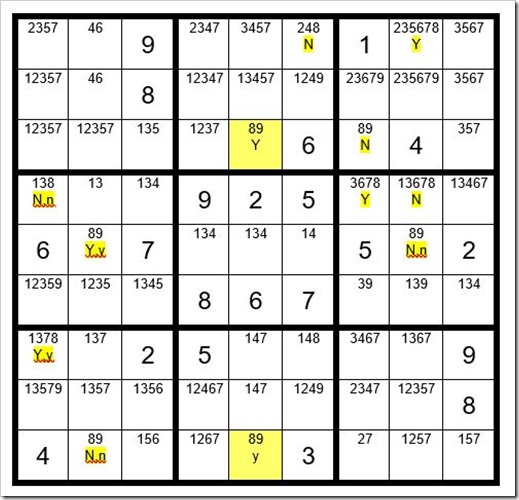
Example # 41.8
|
If C5R3=8 then C7R3 is not an 8, so we will mark that cell with a “N”. If this cell is not an 8, then C8R1 must be an 8 (only other cell in box 3 that could be an 8). Then C8R4 & C8R5 are N, C7R4=Y, then C2R5 is Y, C1R4 is N, C1R7 is Y and C2R9 is N (all as marked above).
Now we will assume C5R9 is the 8. Then C2R9 is n, C1R7 is y, C2R5 is y, C1R4 is n, C8R5 is n.
What does it mean if a cell is marked N,n? What does it mean if a cell is marked Y,y?
We know that one of the 2 yellow cells must be an 8. We have gone through the exercise detailing what the other unsolved cells in the puzzle must be, depending on which yellow cells is an 8. So, a cell with a N,n designation means that it cannot be an 8 regardless of which yellow cell is an 8, so you can remove the 8 as an option from that cell.
If a cell has a Y,y designation, it mean that regardless of which yellow cell is an 8, this cell is an 8. You may now assign an 8 as an answer to these 2 cells.
We now see that C2R9=9, C2R5=8, C8R5=9, C5R9=8, C5R3=9 & C8R3=8. C1R4 options become 13; therefore, C3R4=4. Now your grid should look like Example #41.9 below:
|
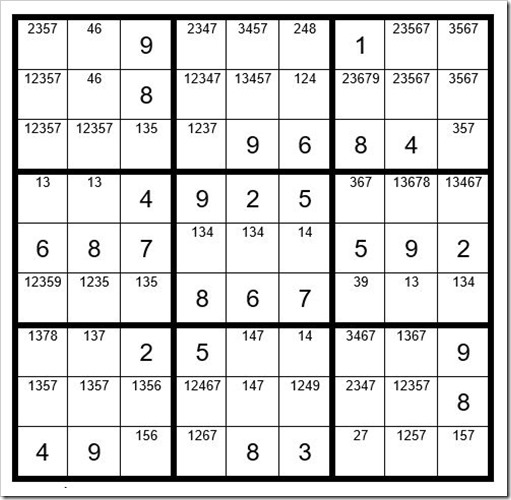
Example #41.9
|
You can now see that there are many more clues in the grid. For example, once you process the obvious pair 13 in row 4, C3R6=5, C2R6=2, C1R6=9. Its all downhill from here, leading to an easy solution, as per Example #41.10 below:
|
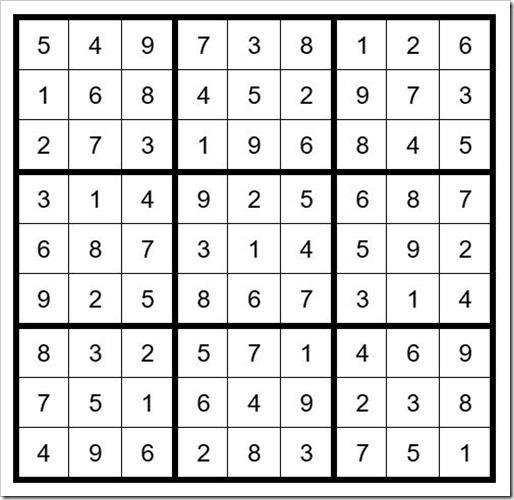
Example #41.10
|
Looking back at Example #41.6 one would think this might be a very challenging puzzle! Indeed, it would without a powerful Step 6.
Enjoy the summer, hopefully at the River.
May the gentle winds of Sudoku be at your back.
Dan LeKander
Editor’s note:
Do you tackle a Sudoku on your cottage veranda, sailboat cockpit, or at a campsite? And now in June… how about the beach!
TI Life is taking full advantage of Dan LeKander, from Wellesley Island, who is a Sudoku expert and author of “3 Advanced Sudoku Techniques – That Will Change Your Game Forever!”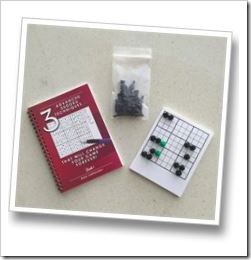
In January 2016, we published a final article in his series – but many of us enjoy using “Dan’s Steps,” so when he asked if we would like a puzzle to solve every month … this editor said an enthusiastic… Yes, please! Now we are three years later and on Puzzle #41!
I suggest you purchase Dan’s book, “3 Advanced Sudoku Techniques, That Will Change Your Game Forever!”
Dan’s book is available online, amazon.com and on ebay.com.
Purchase of a book includes a 50-page blank grid pad, 33 black and two green tokens, to assist with Step 6.…
Most importantly, I ask that you leave comments on any part of his series and throughout the year. Remember when your teacher said – no such thing as a silly question – as we can all learn together.
As always, I want to thank Dan…and his proof reader… Peggy! what a lot of work they put into our TI Life articles.
|